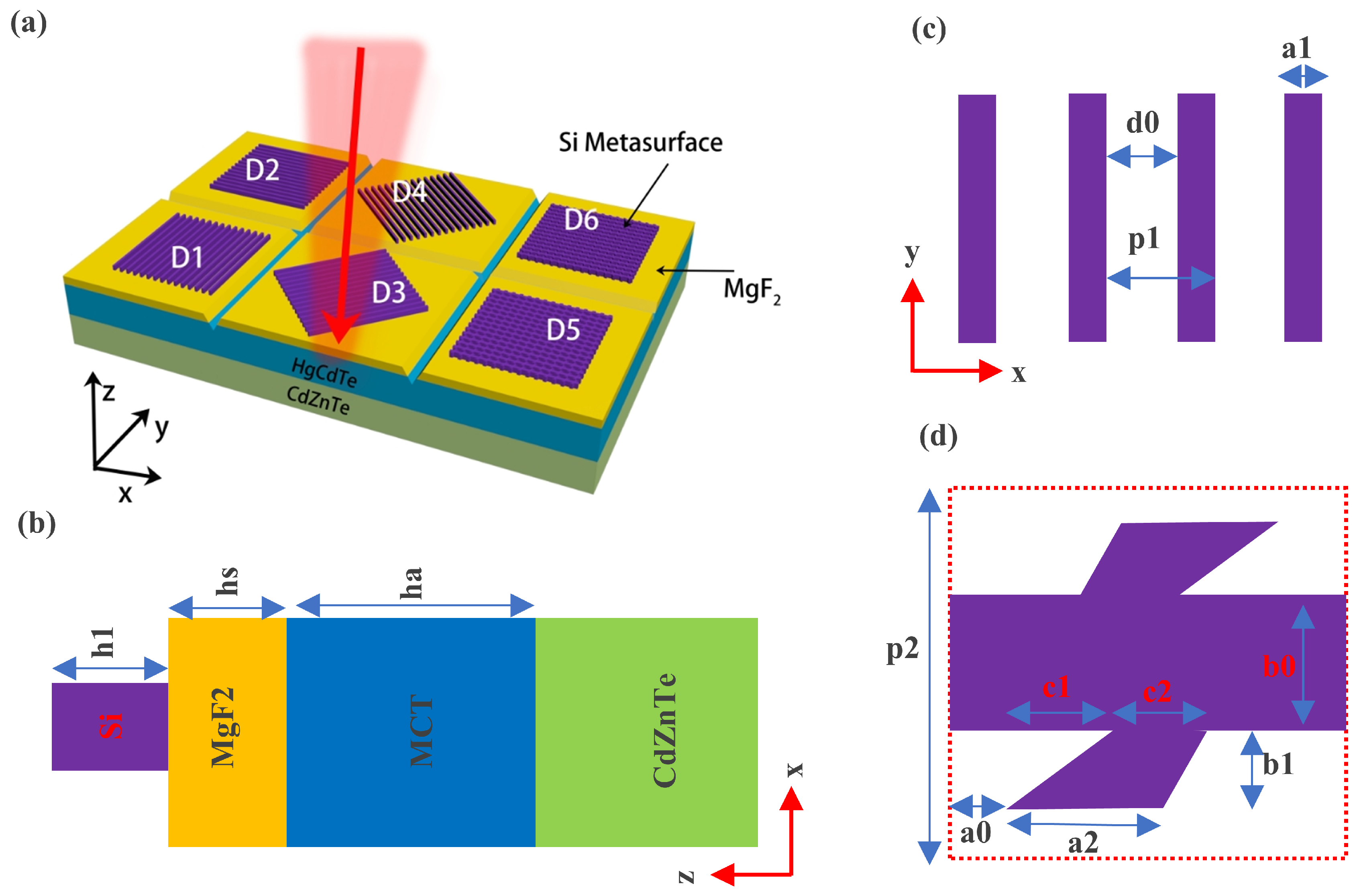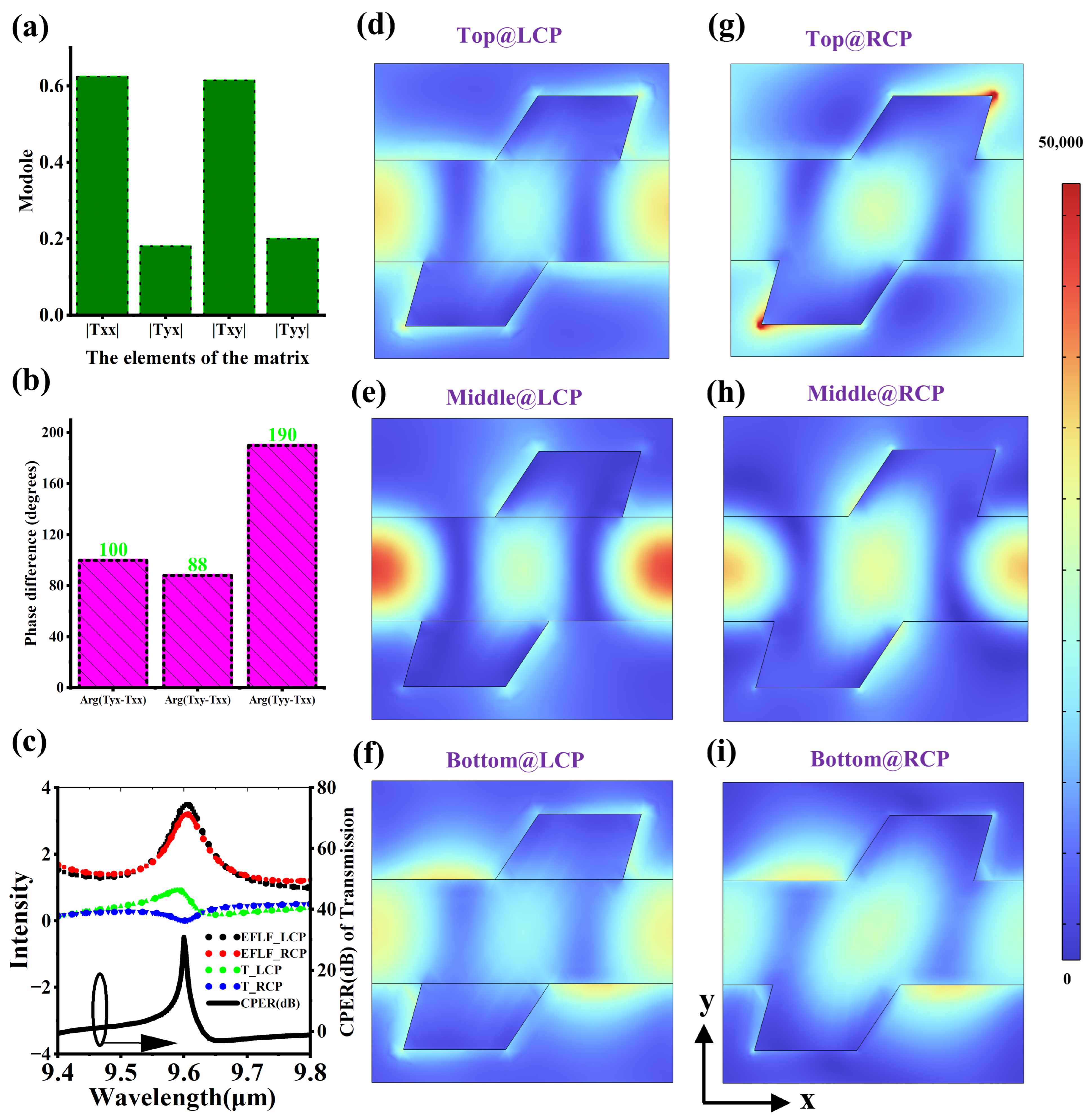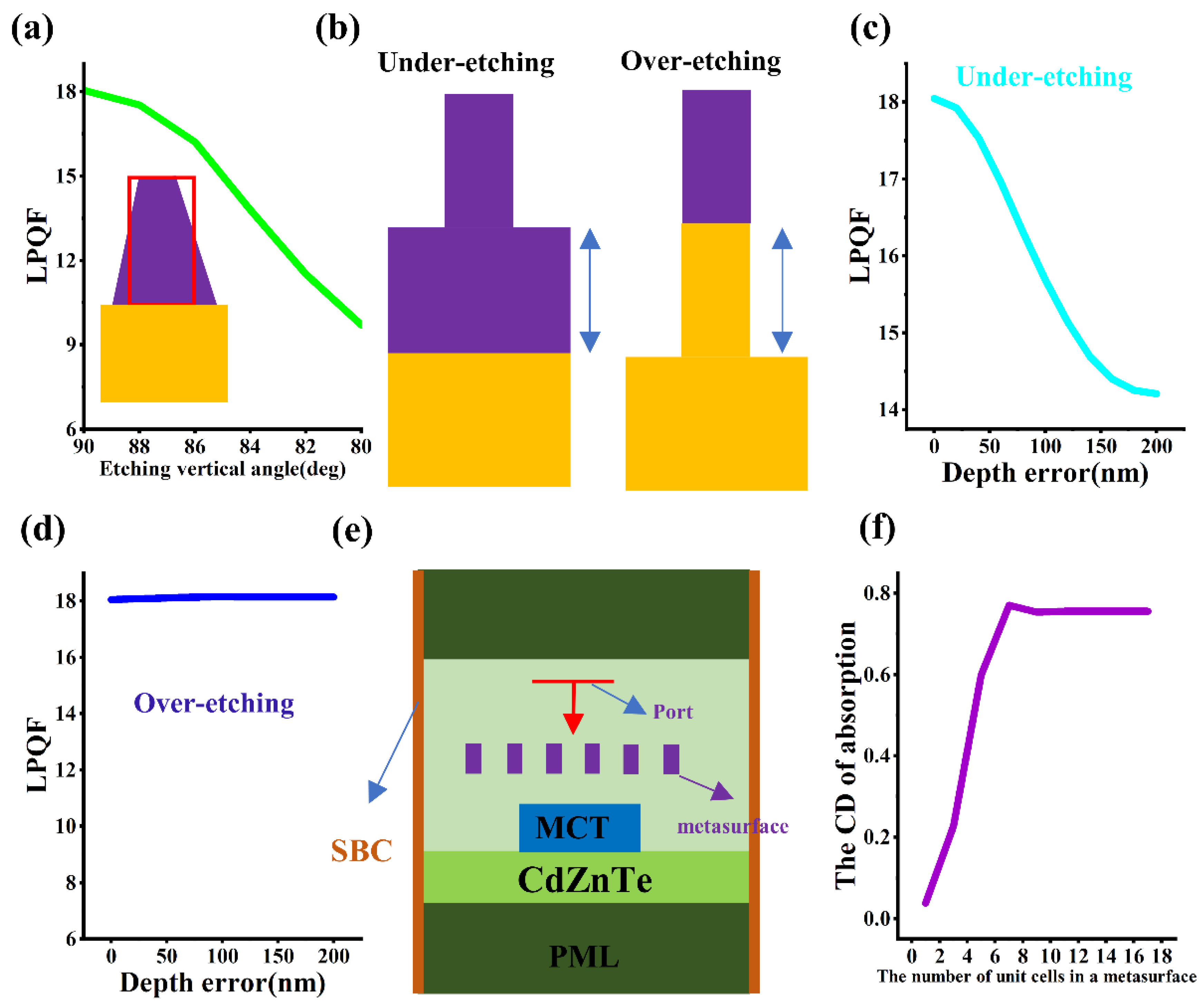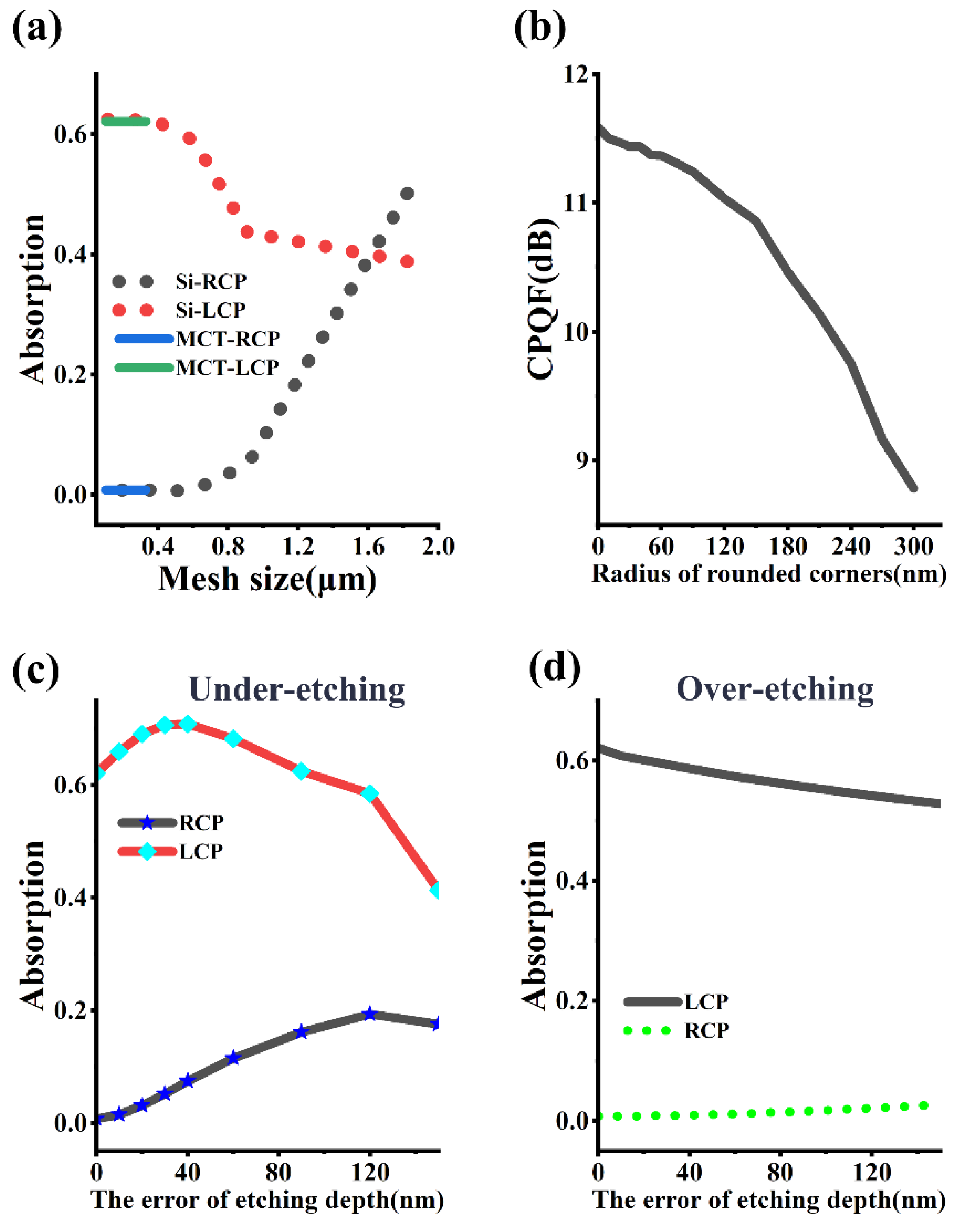Design of Long-Wave Fully Polarized HgCdTe Photodetector Based on Silicon Metasurface
Abstract
1. Introduction
2. Materials and Methods
3. Results
3.1. The Polarization Discrimination Capability of the Linear Grating
3.2. The Circular Dichroism Analysis of Chiral Metasurfaces
3.3. The Parameter Optimization of the Spacer Layer hs
3.4. The Analysis of Potential Errors
4. Discussion
Supplementary Materials
Author Contributions
Funding
Data Availability Statement
Acknowledgments
Conflicts of Interest
References
- Rogalski, A. HgCdTe infrared detector material: History, status and outlook. Rep. Prog. Phys. 2005, 68, 2267–2336. [Google Scholar] [CrossRef]
- Eich, D.; Schirmacher, W.; Hanna, S.; Mahlein, K.M.; Fries, P.; Figgemeier, H. Progress of MCT Detector Technology at AIM Towards Smaller Pitch and Lower Dark Current. J. Electron. Mater. 2017, 46, 5448–5457. [Google Scholar] [CrossRef]
- Marcott, C.; Reeder, R.C. FT-IR spectroscopic imaging microscopy using an MCT focal-plane array detector. Am. Inst. Phys. 1998, 430, 377–378. [Google Scholar]
- Anet, F.A.L.; Kopelevich, M. Detection and assignments of diastereotopic chemical shifts in partially deuteriated methyl groups of a chiral molecule. Cheminform 1989, 111, 3429–3431. [Google Scholar]
- Troitsky, A.V.; Osharin, A.M.; Korolev, A.V.; Strapp, J.W. Polarization of Thermal Microwave Atmospheric Radiation Due to Scattering by Ice Particles in Clouds. J. Atmos. Sci. 2003, 60, 1608–1620. [Google Scholar] [CrossRef]
- Deng, Y.; Meng, C.; Thrane, P.C.V.; Sande, S.I.; Bozhevolnyi, S.I.; Ding, F. MEMS-integrated metasurfaces for dynamic linear polarizers. Optica 2024, 11, 7. [Google Scholar] [CrossRef]
- Han, C.; Tam, W.Y. Plasmonic ultra-broadband polarizers based on Ag nano wire-slit arrays. Appl. Phys. Lett. 2015, 106, 3431–3433. [Google Scholar] [CrossRef]
- Cui, Y.; Azzam, R.M.A. Sixteen-beam grating-based division-of-amplitude photopolarimeter. Opt. Lett. 1996, 21, 89–91. [Google Scholar] [CrossRef]
- Wu, C.; Arju, N.; Fan, J.; Brener, I.; Shvets, G. Spectrally selective chiral silicon metasurfaces based on infrared Fano resonances. In Proceedings of the Lasers & Electro-optics, San Jose, CA, USA, 8–13 June 2014. [Google Scholar]
- Li, Z.; Liu, W.; Cheng, H.; Chen, S.; Tian, J. Tunable dual-band asymmetric transmission for circularly polarized waves with graphene planar chiral metasurfaces. Opt. Lett. 2016, 41, 3142–3145. [Google Scholar] [CrossRef]
- Zhang, N.; Gao, F.; Wang, R.; Shen, Z.; Han, D.; Cui, Y.; Zhang, L.; Chang, C.; Qiu, C.W.; Chen, X. Deep-Learning Empowered Customized Chiral Metasurface for Calibration-Free Biosensing. Adv. Mater. 2025, 37, e2411490. [Google Scholar] [CrossRef]
- Gromyko, D.; Loh, J.S.; Feng, J.; Qiu, C.W.; Wu, L. Enabling All-to-Circular Polarization Up-Conversion by Nonlinear Chiral Metasurfaces with Rotational Symmetry. Phys. Rev. Lett. 2025, 134, 023804. [Google Scholar] [CrossRef]
- Ma, C.; Yu, P.; Jing, Z.; Zhu, Y.; Li, P.; Wang, W.; Xu, H.; Zhang, Y.; Pan, L.; Choi, T.-Y.; et al. Circular polarization-selective optical, photothermal, and optofluidic effects in chiral metasurfaces. Photonics Res. 2024, 12, 331. [Google Scholar] [CrossRef]
- Zhao, Y.; Belkin, M.A.; Alù, A. Twisted optical metamaterials for planarized ultrathin broadband circular polarizers. Nat. Commun. 2012, 3, 870. [Google Scholar] [CrossRef]
- Dietrich, K.; Menzel, C.; Lehr, D.; Puffky, O.; Huebner, U.; Pertsch, T.; Tuennermann, A.; Kley, E.B. Elevating optical activity: Efficient on-edge lithography of three-dimensional starfish metamaterial. Appl. Phys. Lett. 2014, 104, 2517–2534. [Google Scholar] [CrossRef]
- Bachman, K.A.; Peltzer, J.J.; Flammer, P.D.; Furtak, T.E.; Collins, R.T.; Hollingsworth, R.E. Spiral plasmonic nanoantennas as circular polarization transmission filters. Opt. Express 2012, 20, 1308–1319. [Google Scholar] [CrossRef] [PubMed]
- Fedotov, V.A.; Schwanecke, A.S.; Zheludev, N.I.; Khardikov, V.V.; Prosvirnin, S.L. Asymmetric Transmission of Light and Enantiomerically Sensitive Plasmon Resonance in Planar Chiral Nanostructures. Nano Lett. 2007, 7, 1996–1999. [Google Scholar] [CrossRef]
- Cadusch, J.J.; James, T.D.; Djalalian-Assl, A.; Davis, T.J.; Roberts, A. A Chiral Plasmonic Metasurface Circular Polarization Filter. IEEE Photonics Technol. Lett. 2014, 26, 2357–2360. [Google Scholar] [CrossRef]
- Zuo, J.; Bai, J.; Choi, S.; Basiri, A.; Chen, X.; Wang, C.; Yao, Y. Chip-integrated metasurface full-Stokes polarimetric imaging sensor. Light Sci. Appl. 2023, 12, 218. [Google Scholar] [CrossRef]
- Li, L.W.; Rubin, N.A.; Juhl, M.; Park, J.-S.; Capasso, F. Evaluation and characterization of imaging polarimetry through metasurface polarization gratings. Appl. Opt. 2023, 62, 1704–1722. [Google Scholar] [CrossRef]
- Li, W.; Coppens, Z.J.; Besteiro, L.V.; Wang, W.; Govorov, A.O.; Valentine, J. Circularly polarized light detection with hot electrons in chiral plasmonic metamaterials. Nat. Commun. 2015, 6, 8379. [Google Scholar] [CrossRef]
- Maksimov, A.A.; Tartakovskii, I.I.; Filatov, E.V.; Lobanov, S.V.; Gippius, N.A.; Tikhodeev, S.G.; Schneider, C.; Kamp, M.; Maier, S.; Höfling, S.; et al. Circularly polarized light emission from chiral spatially-structured planar semiconductor microcavities. Phys. Rev. B 2014, 89, 107–114. [Google Scholar] [CrossRef]
- Lobanov, S.V.; Weiss, T.; Gippius, N.A.; Tikhodeev, S.G.; Kulakovskii, V.D.; Konishi, K.; Kuwata-Gonokami, M. Polarization control of quantum dot emission by chiral photonic crystal slabs. Opt. Lett. 2015, 40, 1528. [Google Scholar] [CrossRef] [PubMed]
- Lobanov, S.V.; Tikhodeev, S.G.; Gippius, N.A.; Maksimov, A.A.; Hfling, S. Controlling circular polarization of light emitted by quantum dots using chiral photonic crystal slab. Phys. Rev. B 2015, 92, 205309. [Google Scholar] [CrossRef]
- Basiri, A.; Chen, X.; Bai, J.; Amrollahi, P.; Carpenter, J.; Holman, Z.; Wang, C.; Yao, Y. Nature-inspired chiral metasurfaces for circular polarization detection and full-Stokes polarimetric measurements. Light. Sci. Appl. 2019, 8, 78. [Google Scholar] [CrossRef]
- Hu, J.; Zhang, C.; Dong, Y.; Zeng, A.; Wang, C. High efficiency all-dielectric pixelated metasurface for near-infrared full-Stokes polarization detection. Photonics Res. 2021, 9, 583–589. [Google Scholar]
- Cheng, B.; Zou, Y.; Shao, H.; Li, T.; Song, G. Full-Stokes imaging polarimetry based on a metallic metasurface. Opt. Express 2020, 28, 27324–27336. [Google Scholar] [CrossRef]
- Cheng, B.; Zou, Y.; Song, G. Ultra-large bandwidth fully polarized photodetectors based on displacement-induced chiral dielectric metasurfaces. Appl. Opt. 2025, 64, 2332–2338. [Google Scholar] [CrossRef]
- Cheng, B.; Zou, Y.; Song, G. Full-stokes polarization photodetector based on the chiral metasurface with the dislocated double gold rod configurations. Opt. Laser Technol. 2024, 174, 110531. [Google Scholar] [CrossRef]
- Miyazaki, H.T.; Mano, T.; Kasaya, T.; Osato, H.; Watanabe, K.; Sugimoto, Y.; Kawazu, T.; Arai, Y.; Shigetou, A.; Ochiai, T.; et al. Synchronously wired infrared antennas for resonant single-quantum-well photodetection up to room temperature. Nat. Commun. 2020, 11, 565. [Google Scholar] [CrossRef]
- Ogawa, S.; Kimata, M. Wavelength- or Polarization-Selective Thermal Infrared Detectors for Multi-Color or Polarimetric Imaging Using Plasmonics and Metamaterials. Materials 2017, 10, 493. [Google Scholar] [CrossRef]
- Chen, C.; Huang, Y.; Wu, K.; Bifano, T.G.; Anderson, S.W.; Zhao, X.; Zhang, X. Polarization insensitive, metamaterial absorber-enhanced long-wave infrared detector. Opt. Express 2020, 28, 28843–28857. [Google Scholar] [CrossRef]
- Tan, X.; Zhang, H.; Li, J.; Wan, H.; Guo, Q.; Zhu, H.; Liu, H.; Yi, F. Non-dispersive infrared multi-gas sensing via nanoantenna integrated narrowband detectors. Nat. Commun. 2020, 11, 5245. [Google Scholar] [CrossRef]
- Pustelny, T.; Struk, P.; Mergo, P.; Wojtas, J.; Martyniuk, P.; Kopytko, M.; Grodecki, K.; Gawron, W.; Gomuka, E. High operating temperature long-wave HgCdTe detector for fast response operation: Optimization approach. In Proceedings of the 11th Conference on Integrated Optics: Sensors, Sensing Structures, and Methods, Szczyrk, Poland, 29 February–4 March 2016. [Google Scholar]
- Forrest, W. Development of Long-Wave HgCdTe Detector Arrays for Future Space Missions. NASA APRA Propos. 2012, 12-APRA12. [Google Scholar]
- Hu, W.; Ye, Z.; Liao, L.; Chen, H.; Lu, W. A 128×128 long-wavelength/mid-wavelength two-color HgCdTe infrared focal plane array detector with ultra-low spectral crosstalk. Opt. Lett. 2014, 39, 5184–5187. [Google Scholar] [CrossRef]
- Ehsan, A.; Mahsa, K.S.; Amir, A.; Andrei, F. Full Stokes imaging polarimetry using dielectric metasurfaces. ACS Photonics 2018, 5, 3132–3140. [Google Scholar] [CrossRef]
- Sen, S.; Rhiger, D.R.; Curtis, C.R.; Kalisher, M.H.; Hettich, H.L.; Currie, M.C. Infrared absorption behavior in CdZnTe substrates. J. Electron. Mater. 2001, 30, 611–618. [Google Scholar] [CrossRef]







Disclaimer/Publisher’s Note: The statements, opinions and data contained in all publications are solely those of the individual author(s) and contributor(s) and not of MDPI and/or the editor(s). MDPI and/or the editor(s) disclaim responsibility for any injury to people or property resulting from any ideas, methods, instructions or products referred to in the content. |
© 2025 by the authors. Licensee MDPI, Basel, Switzerland. This article is an open access article distributed under the terms and conditions of the Creative Commons Attribution (CC BY) license (https://creativecommons.org/licenses/by/4.0/).
Share and Cite
Cheng, B.; Wang, X.; Zou, Y.; Song, G.; Zhai, K.; Wang, X. Design of Long-Wave Fully Polarized HgCdTe Photodetector Based on Silicon Metasurface. Micromachines 2025, 16, 937. https://doi.org/10.3390/mi16080937
Cheng B, Wang X, Zou Y, Song G, Zhai K, Wang X. Design of Long-Wave Fully Polarized HgCdTe Photodetector Based on Silicon Metasurface. Micromachines. 2025; 16(8):937. https://doi.org/10.3390/mi16080937
Chicago/Turabian StyleCheng, Bo, Xiaoming Wang, Yuxiao Zou, Guofeng Song, Kunpeng Zhai, and Xiaojun Wang. 2025. "Design of Long-Wave Fully Polarized HgCdTe Photodetector Based on Silicon Metasurface" Micromachines 16, no. 8: 937. https://doi.org/10.3390/mi16080937
APA StyleCheng, B., Wang, X., Zou, Y., Song, G., Zhai, K., & Wang, X. (2025). Design of Long-Wave Fully Polarized HgCdTe Photodetector Based on Silicon Metasurface. Micromachines, 16(8), 937. https://doi.org/10.3390/mi16080937





